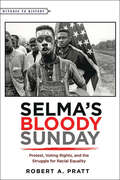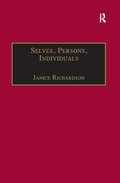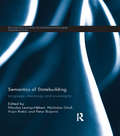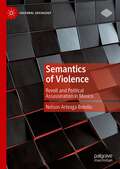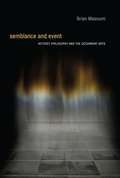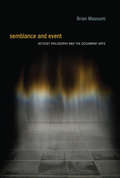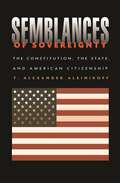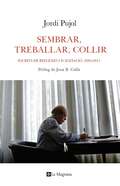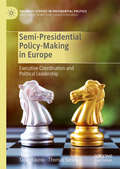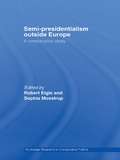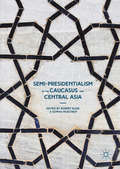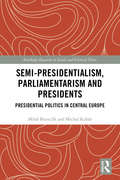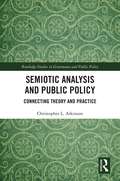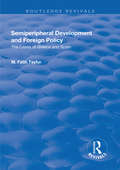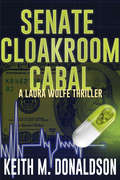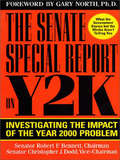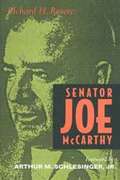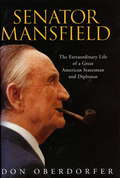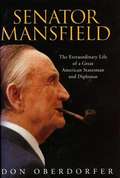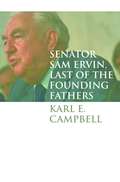- Table View
- List View
Selma's Bloody Sunday: Protest, Voting Rights, and the Struggle for Racial Equality (Witness to History)
by Robert A. Pratt“A fresh look at this historical crossroads which marked the culmination of the Civil Rights Movement . . . timely and engaging.” —Patricia Sullivan, author of Justice RisingOn Sunday afternoon, March 7, 1965, roughly six hundred peaceful demonstrators set out from Brown Chapel A.M.E. Church in a double-file column to march from Selma, Alabama, to the state capital of Montgomery. Leading the march were Hosea Williams of the Southern Christian Leadership Conference and John Lewis of the Student Nonviolent Coordinating Committee. Upon reaching Broad Street, the marchers turned left to cross the Edmund Pettus Bridge that spanned the Alabama River. The violence and horror that was about to unfold at the foot of the bridge would forever mark the day as “Bloody Sunday,” one of the pivotal moments of the civil rights movement. Alabama state troopers fell on the unarmed protestors as they crossed the bridge, beating and tear gassing them. In Selma’s Bloody Sunday, Robert A. Pratt offers a vivid account of that infamous day and the indelible triumph of black and white protest over white resistance. He explores how the march itself—and the 1965 Voting Rights Act that followed—represented a reaffirmation of the nation’s centuries-old declaration of universal equality and the fulfillment of the Fifteenth Amendment to the Constitution.Selma’s Bloody Sunday offers a fresh interpretation of the ongoing struggle by African Americans to participate freely in America’s electoral democracy. Jumping forward to the present day, Pratt uses the march as a lens through which to examine disturbing recent debates concerning who should, and who should not, be allowed to vote.
Selma’s Bloody Sunday: Protest, Voting Rights, and the Struggle for Racial Equality (Witness to History)
by Robert A. PrattThe march from Selma to Montgomery starkly illustrated the claims of the civil rights movement—and the raw brutality of the forces arrayed against it.On Sunday afternoon, March 7, 1965, roughly six hundred peaceful demonstrators set out from Brown Chapel A.M.E. Church in a double-file column to march from Selma, Alabama, to the state capital of Montgomery. Leading the march were Hosea Williams of the Southern Christian Leadership Conference and John Lewis of the Student Nonviolent Coordinating Committee. Upon reaching Broad Street, the marchers turned left to cross the Edmund Pettus Bridge that spanned the Alabama River. "When we reached the crest of the bridge," recalls John Lewis, "I stopped dead still. So did Hosea. There, facing us at the bottom of the other side, stood a sea of blue-helmeted, blue-uniformed Alabama state troopers, line after line of them, dozens of battle-ready lawmen stretched from one side of U.S. Highway 80 to the other. Behind them were several dozen more armed men—Sheriff Clark’s posse—some on horseback, all wearing khaki clothing, many carrying clubs the size of baseball bats."The violence and horror that was about to unfold at the foot of the bridge would forever mark the day as "Bloody Sunday," one of the pivotal moments of the civil rights movement. Alabama state troopers fell on the unarmed protestors as they crossed the bridge, beating and tear gassing them. In Selma’s Bloody Sunday, Robert A. Pratt offers a vivid account of that infamous day and the indelible triumph of black and white protest over white resistance. He explores how the march itself—and the 1965 Voting Rights Act that followed—represented a reaffirmation of the nation’s centuries-old declaration of universal equality and the fulfillment of the Fifteenth Amendment to the Constitution.Selma’s Bloody Sunday offers a fresh interpretation of the ongoing struggle by African Americans to participate freely in America’s electoral democracy. Jumping forward to the present day, Pratt uses the march as a lens through which to examine disturbing recent debates concerning who should, and who should not, be allowed to vote. Drawing on archival materials, secondary sources, and eyewitness accounts of the brave men and women who marched, this gripping account offers a brief and nuanced narrative of this critical phase of the black freedom struggle.
Selves, Persons, Individuals: Philosophical Perspectives on Women and Legal Obligations
by Janice RichardsonWhilst feminist philosophy has frequently engaged with political theory, this original book instead considers legal theory and the practical operation of law. The work considers some of the contested meanings of what it is to be a self, a person or an individual in relation to the law of obligations. The discussion still impacts upon political theory as it concerns the way in which the question of what it is to be a woman has been defined within recent feminist theory. In order to overcome what appears to be a block in feminist legal theory, the book draws together areas of philosophy which are not normally considered within feminist or legal theory.
Semantics of Statebuilding: Language, meanings and sovereignty (Routledge Studies in Intervention and Statebuilding)
by Nicolas Lemay-Hébert, Nicholas Onuf, Vojin Rakić and Petar BojanićThis volume examines international statebuilding in terms of language and meanings, rather than focusing narrowly on current policy practices. After two decades of evolution towards more ‘integrated,’ ‘multi-faceted’ or, simply stated, more intrusive statebuilding and peacebuilding operations, a critical literature has slowly emerged on the economic, social and political impacts of these interventions. Scholars have started to analyse the ‘unintended consequences’ of peacebuilding missions, analysing all aspects of interventions. Central to the book is the understanding that language is both the most important tool for building anything of social significance, and the primary repository of meanings in any social setting. Hence, this volume exemplifies how the multiple realities of state, state fragility and statebuilding are being conceptualised in mainstream literature, by highlighting the repercussions this conceptualisation has on ‘good practices’ for statebuilding. Drawing together leading scholars in the field, this project provides a meeting point between constructivism in international relations and the critical perspective on liberal peacebuilding, shedding new light on the commonly accepted meanings and concepts underlying the international (or world) order, as well as the semantics of contemporary statebuilding practices. This book will be of much interest to students of statebuilding and intervention, war and conflict studies, security studies and international relations.
Semantics of Violence: Revolt and Political Assassination in Mexico (Cultural Sociology)
by Nelson Arteaga BotelloThis book describes three impactful cases of political violence that broke out in Mexico in 1994, pointing to an important juncture in Mexican political development. At that point, the patrimonial order centered on the PRI and the Mexican presidency entered a momentous crisis that is still ongoing after a quarter of a century and caused the patrimonial order and the civil order to compete over Mexican public life. Such competition, in turn, unfolds at the cultural level on the terrain of three semantics of political violence that shape public debates over violence in Mexico. Ultimately, this book sheds light over the refraction of patrimonial and civil attributions across such cultural terrains.
Semblance and Event
by Brian MassumiEvents are always passing; to experience an event is to experience the passing. But how do we perceive an experience that encompasses the just-was and the is-about-to-be as much as what is actually present? In Semblance and Event, Brian Massumi, drawing on the work of William James, Alfred North Whitehead, Gilles Deleuze, and others, develops the concept of "semblance" as a way to approach this question. It is, he argues, a question of abstraction, not as the opposite of the concrete but as a dimension of it: "lived abstraction. " A semblance is a lived abstraction. Massumi uses the category of the semblance to investigate practices of art that are relational and event-oriented--variously known as interactive art, ephemeral art, performance art, art intervention--which he refers to collectively as the "occurrent arts. " Massumi argues that traditional art practices, including perspective painting, conventionally considered to be object-oriented freeze frames, also organize events of perception, and must be considered occurrent arts in their own way. Each art practice invents its own kinds of relational events of lived abstraction, to produce a signature species of semblance. The artwork's relational engagement, Massumi continues, gives it a political valence just as necessary and immediate as the aesthetic dimension. Massumi investigates occurrent art practices in order to examine, on the broadest level, how the aesthetic and the political are always intertwined in any creative activity.
Semblance and Event: Activist Philosophy and the Occurrent Arts (Technologies of Lived Abstraction)
by Brian MassumiAn investigation of the “occurrent arts” through the concepts of the “semblance” and “lived abstraction.”Events are always passing; to experience an event is to experience the passing. But how do we perceive an experience that encompasses the just-was and the is-about-to-be as much as what is actually present? In Semblance and Event, Brian Massumi, drawing on the work of William James, Alfred North Whitehead, Gilles Deleuze, and others, develops the concept of “semblance” as a way to approach this question. It is, he argues, a question of abstraction, not as the opposite of the concrete but as a dimension of it: “lived abstraction.” A semblance is a lived abstraction. Massumi uses the category of the semblance to investigate practices of art that are relational and event-oriented—variously known as interactive art, ephemeral art, performance art, art intervention—which he refers to collectively as the “occurrent arts.” Each art practice invents its own kinds of relational events of lived abstraction, to produce a signature species of semblance. The artwork's relational engagement, Massumi continues, gives it a political valence just as necessary and immediate as the aesthetic dimension.
Semblances of Sovereignty: The Constitution, the State, and American Citizenship
by T. Alexander AleinikoffIn a set of cases decided at the end of the nineteenth century, the Supreme Court declared that Congress had "plenary power" to regulate immigration, Indian tribes, and newly acquired territories. Not coincidentally, the groups subject to Congress' plenary power were primarily nonwhite and generally perceived as "uncivilized." The Court left Congress free to craft policies of assimilation, exclusion, paternalism, and domination.Despite dramatic shifts in constitutional law in the twentieth century, the plenary power case decisions remain largely the controlling law. The Warren Court, widely recognized for its dedication to individual rights, focused on ensuring "full and equal citizenship"--an agenda that utterly neglected immigrants, tribes, and residents of the territories. The Rehnquist Court has appropriated the Warren Court's rhetoric of citizenship, but has used it to strike down policies that support diversity and the sovereignty of Indian tribes.Attuned to the demands of a new century, the author argues for abandonment of the plenary power cases, and for more flexible conceptions of sovereignty and citizenship. The federal government ought to negotiate compacts with Indian tribes and the territories that affirm more durable forms of self-government. Citizenship should be "decentered," understood as a commitment to an intergenerational national project, not a basis for denying rights to immigrants.
Sembrar, treballar, recollir: Escrits de reflexió i d'agitació, 2005-2011
by Jordi PujolUn recull dels 250 textos de l' Butlletí del Centre d'Estudis Jordi Pujol entre 2005 i 2011. Des que va deixar la presidència de la Generalitat de Catalunya a finals del 2003, Jordi Pujol ha mantingut una presència pública constant i molt escoltada. Alliberat de la càrrega diària de la gestió pública però armat d'un bagatge impressionant i respectat, ha fet sentir la seva veu en conferències, articles, intervencions de molt diversa índole. D'entre totes aquestes, la plataforma on ha deixat constància més regularment de la seva visió del país i de l'esdevenir de la història ha estat als editorials del Butlletí del Centre d'Estudis Jordi Pujol. Entre 2005 i 2011 el president Pujol ha escrit més de 250 textos breus de reflexió política i anàlisi social, tot construint un relat profundament lúcid i suggeridor sobre el nostre passat recent, donant claus d'interpretació del present i obrint perspectives de futur. Aquest volum reuneix el conjunt d'aquests editorials fins a l'estiu de 2011. Amb pròleg de l'historiador Joan B. Culla, el llibre conté els textos ordenats de forma cronològica per subratllar el valor de testimoniatge d'un temps que els caracteritzen. Així mateix, inclou tres índexs, situats al final de l'obra: de títols, onomàstic i temàtic.
Semi-Citizenship in Democratic Politics
by Elizabeth F. CohenIn every democratic polity there exist individuals and groups who hold some but not all of the essential elements of citizenship. Scholars who study citizenship routinely grasp for shared concepts and language that identify forms of membership held by migrants, children, the disabled, and other groups of individuals who, for various reasons, are neither full citizens nor non-citizens. This book introduces the concept of semi-citizenship as a means to dramatically advance debates about individuals who hold some but not all elements of full democratic citizenship. By analytically classifying the rights of citizenship and their various combinations, scholars can typologize semi-citizens and produce comparisons of different kinds of semi-citizenships and of semi-citizenships in different states. The book uses theoretical analysis, historical examples, and contemporary cases of semi-citizenship to illustrate how normative and governmental doctrines of citizenship converge and conflict, making semi-citizenship an enduring and inevitable part of democratic politics.
Semi-Presidential Policy-Making in Europe: Executive Coordination and Political Leadership (Palgrave Studies in Presidential Politics)
by Tapio Raunio Thomas SedeliusThis book explores how power-sharing between the president and the prime minister works in semi-presidential regimes. In contrast to much of the existing comparative work on semi-presidentialism, the book emphasizes the role of institutional coordination at the most concrete level of executive policy-making, and asks how institutional coordination between the president and prime minister influences presidential activism and the balance of power within the executive. The authors develop a tentative framework embedded in institutionalism and based on four strands of research – semi-presidentialism, public administration, political leadership, and foreign policy analysis – which is subsequently applied to the cases of Lithuania, Romania and Finland. Given the political challenges facing many semi-presidential countries, the study ultimately seeks to identify institutional solutions that facilitate power-sharing and successful policy-making.
Semi-Presidentialism Outside Europe: A Comparative Study (Routledge Research in Comparative Politics #Vol. 19)
by Robert Elgie Sophia MoestrupThis is the first academic study of the impact of semi-presidentialism in emerging democracies outside of Europe. Semi-presidentialism is where there is both a directly-elected fixed-term president and a prime minister who is responsible to the legislature. For the most part, semi-presidentialism is seen as being a risky choice for new democracies because it can create potentially destabilizing competition between the president and prime minister. And yet, there are now more than fifty semi-presidential countries in the world. Moreover, many of these countries are in Africa, the former Soviet Union and Asia, often in places where democracy has yet to establish a firm foundation. This study begins with a chapter that discusses the advantages and disadvantages of semi-presidentialism and provides the theoretical framework for a wide-ranging series of country chapters presented in the second part of the book. Written by country/area specialists, the case studies highlight the political processes at work in young semi-presidential democracies. Semi-Presidentialism Outside Europe will appeal to those researching and studying in the fields of comparative politics, development and democracy.
Semi-Presidentialism and Democracy
by Robert Elgie Sophia Moestrup Yu-Shan WuExplores the effect of semi-presidentialism on newly-democratising countries. In recent years semi-presidentialism - the situation where a constitution makes provision for both a directly elected president and a prime minister who is responsible to the legislature - has become the regime type of choice for many countries.
Semi-Presidentialism in the Caucasus and Central Asia
by Robert Elgie Sophia MoestrupThis edited collection examines the politics of semi-presidential countries in the Caucasus and Central Asia. Semi-presidentialism is the situation where there is both a directly elected fixed-term president and a prime minister and cabinet that are collectively responsible for the legislature. There are four countries with a semi-presidential constitution in this region - Armenia, Azerbaijan, Georgia, and Kyrgyzstan. The authors introduce the concept of semi-presidentialism, place the countries in a general post-Soviet context, and compare them with Kazakhstan. They investigate the relationship between semi-presidentialism in the formal constitution and the verticality of power in reality, explore the extent to which semi-presidentialism has been responsible for the relative performance of democracy in each country, and chart the relationship within the executive both between the president, prime minister and ministers, and between the executive and the legislature.
Semi-presidentialism, Parliamentarism and Presidents: Presidential Politics in Central Europe (Routledge Research on Social and Political Elites)
by Miloš Brunclík Michal KubátThe book analyzes the presidencies of three neighboring Central European countries – Poland, the Czech Republic and Slovakia – in the context of their interactions with cabinets (and prime ministers), parliaments and the constitutional courts, all which have proved crucial actors in the region’s political and constitutional battles. Using both institutional and behavioral perspectives along with an innovative definition of semi-presidentialism, the book argues that presidential powers – rather than the mode of the election of the president – are crucial to the functioning of the regimes and their classification into distinctive regime types. Focusing on intra-executive conflicts and the interaction of the president with other constitutional players it argues that, regardless of the mode of the election of the president, regimes have traditionally been very similar not only in their institutional settings, but also in the way they function. Finally, it shows that Poland, the Czech Republic and Slovakia should be classified as parliamentary regimes. This text will be of key interest to scholars and students of Central and East Europe studies/politics, post-Communist studies, presidential studies and more broadly to political elites and institutions, comparative politics and legislative studies.
Semiotic Analysis and Public Policy: Connecting Theory and Practice (Routledge Studies in Governance and Public Policy)
by Christopher L. AtkinsonSemiotic Analysis and Public Policy evaluates several key areas of public policy that are dependent on narrative, naming, sign, and branding to create meaning. Semiotic analysis, drawing on the work of Saussure, Peirce, and others, allows for creation of a case-oriented model of brand versus product, and of medium compared with message. Using a critical Habermasian lens, Atkinson convincingly exposes approaches focusing too heavily on instrumentality and rhetoric that claims a resolution of complex societal dilemmas. Rooted in the literature on public policy and semiotics, Atkinson creates an opportunity to delve more fully into the creation of narratives and meaning in policy, and the origins and maintenance of public programs. Evaluation of such programs shows various levels of disconnect between popular understanding of public considerations, political outcomes, and what results from the administrative/regulatory process in support of the law. This book will be of interest for scholars and researchers of public policy, policy analysis, public administration, public management, and policy implementation.
Semiperipheral Development and Foreign Policy: The Cases of Greece and Spain
by M. Fatih TayfurThis title was first published in 2003.Tayfur's theoretical approach to foreign policy analysis is original and represents an extremely valuable addition to a field which is under-theorised. It develops the World-System theory of Wallerstein and Arrighi. In applying this theory to two case studies, Tayfur offers a detailed account of the domestic and foreign policies of Greece and Spain after the Second World War. He illuminates in particular their turn from a foreign policy orientation towards the United States to a growing identification with, and eventual integration into, the European Community. This original book is pertinent to a range of contemporary debates and suitable to feature on the reading lists of every course on foreign policy analysis and international political theory. In addition, students of comparative politics, political transition and Mediterranean studies, will find this book particularly useful.
Senate Cloakroom Cabal: A Laura Wolfe Thriller (Laura Wolfe Thriller Series #2)
by Keith M. Donaldson"We don't manufacture cures. We manufacture dependencies." So says the head pharmaceutical lobbyist to the majority leader of the United States Senate. Soon after that utterance, a miracle-cure cancer drug is rejected by the US Food and Drug Administration because of purported side effects.A first-year senator, Roanne Dalton senses illegal activity in her own party, but is powerless to act on her own. Instead, she seeks an objective investigator and turns to the well-respected and savvy Washington Daily Star reporter Laura Wolfe. Senator Dalton and Laura suspect a Capitol Hill conspiracy with horrific consequences--keeping this anxiously awaited drug away from the American people--a conspiracy of greed and deceit that, without warning, turns deadly. Senate Cloakroom Cabal is the second installment in the thrilling Laura Wolfe series, following Death of an Intern.
Senate Special Report on Y2K
by Robert BennettInvestigating the impact of the year 2000 problem. Book by Dodd, Christopher J., Bennett, Robert F.
Senator Hattie Caraway: An Arkansas Legacy
by Nancy HendricksThe forgotten story of the first woman elected to the US Senate, and her historic career during the Depression and Second World War—includes photos.Hattie Caraway unexpectedly became a United States senator in 1931 by filling the seat of her late husband. But what her colleagues viewed as an honorary position was in fact the start of a distinguished career. Despite strong male opposition, Hattie won reelection—and loyally and effectively served her Arkansas constituency for twelve years through the difficult times of the Great Depression and World War II. In this biography Caraway scholar Dr. Nancy Hendricks recounts Senator Caraway’s historic career through previously unseen letters and photos, and shows how Caraway effected change in the American political landscape.
Senator James Eastland: Mississippi's Jim Crow Democrat (Making the Modern South)
by Maarten ZwiersIn the years following World War II, the national Democratic Party aligned its agenda more and more with the goals of the civil rights movement. By contrast, a majority of southern Democrats remained as committed as ever to a traditional, segregationist ideology. Through the career of Senator James Eastland, one of the mid-century's most prominent politicians, author Maarten Zwiers explores the uneasy, yet mutually beneficial relationship between conservative southerners and the increasingly liberal party to which they belonged. Mississippi Democrat James "Big Jim" Eastland began an influential four-decade career in the United States Senate in 1941, ultimately rising to become president pro tempore of the Senate, a position that placed him third in the line of presidential succession. His reputation for toughness developed from his unfailing and ruthless opposition to greater civil rights and his concern over the global spread of communism, as he believed participants in the two movements were working together to undermine the American way of life. Zwiers contends that despite Eastland's extreme positions, he still managed to maintain influence through productive relationships with his Senate colleagues-liberal as well as conservative. Though the progressive wing of the Democratic Party continued to push for stronger civil rights legislation, they valued compromise with southern senators like Eastland in order to ensure support from a region the Democrats could ill afford to lose. While Eastland's campaigning rhetoric was inflammatory, his ability to operate within the national political structure by leveraging moderate concessions contributed to his lengthy and effective career. Drawing on recently opened archival records, Maarten Zwiers offers a nuanced portrait of a man frequently portrayed as a southern zealot. Senator James Eastland provides a case study of the complicated relationship between party and party members that allowed Democrats to maintain power in the South for much of the twentieth century.
Senator Joe McCarthy
by Richard H. RovereRichard Rovere documents the process by which a clever, power hungry individual came to mislead and manipulate members of Congress and the American public and to damage countless lives. A new foreword for this edition by Arthur M. Schlesinger Jr. places the book in historical context and relates it to current issues in American public life.
Senator Mansfield
by Don OberdorferA spellbinding biography of one of the most powerful and dignified men ever to come to DC--Senator Mike Mansfield.Mike Mansfield's career as the longest serving majority leader is finally given its due in this extraordinary biography. In many respects, Mansfield's dignity and decorum represent the high-water mark of the US Senate: he was respected as a leader who helped build consensus on tough issues and was renowned for his ability to work across the aisle and build strong coalitions. Amazingly, he would have breakfast every morning with a member of the opposing party.Mansfield was instrumental in pushing through some of the most influential legislation of the twentieth century. He was at the helm when the Senate passed landmark legislation such as the Civil Rights Act of 1964, the Voting Rights Act of 1965, the creation of Medicare, and the nuclear test ban treaty. Mansfield played a crucial role in shaping America's foreign policy, corresponding with JFK about his opposition to the growing presence of the US in Southeast Asia. As ambassador to Japan, his conversations with Cambodia and China paved the way for Nixon's historic trip to China in 1972.
Senator Mansfield: The Extraordinary Life of a Great Statesman and Diplomat
by Don OberdorferA spellbinding biography of one of the most powerful and dignified men ever to come to DC-Senator Mike Mansfield. Mike Mansfield's career as the longest serving majority leader is finally given its due in this extraordinary biography. In many respects, Mansfield's dignity and decorum represent the high-water mark of the US Senate: he was respected as a leader who helped build consensus on tough issues and was renowned for his ability to work across the aisle and build strong coalitions. Amazingly, he would have breakfast every morning with a member of the opposing party. Mansfield was instrumental in pushing through some of the most influential legislation of the twentieth century. He was at the helm when the Senate passed landmark legislation such as the Civil Rights Act of 1964, the Voting Rights Act of 1965, the creation of Medicare, and the nuclear test ban treaty. Mansfield played a crucial role in shaping America's foreign policy, corresponding with JFK about his opposition to the growing presence of the US in Southeast Asia. As ambassador to Japan, his conversations with Cambodia and China paved the way for Nixon's historic trip to China in 1972.
Senator Sam Ervin, Last of the Founding Fathers
by Karl E. CampbellMany Americans remember Senator Sam Ervin (1896-1985) as the affable, Bible-quoting, old country lawyer who chaired the Senate Watergate hearings in 1973. Ervin's stories from down home in North Carolina, his reciting literary passages ranging from Shakespeare to Aesop's fables, and his earnest lectures in defense of civil liberties and constitutional government contributed to the downfall of President Nixon and earned Senator Ervin a reputation as "the last of the founding fathers."Yet for most of his twenty years in the Senate, Ervin applied these same rhetorical devices to a very different purpose. Between 1954 and 1974, he was Jim Crow's most talented legal defender as the South's constitutional expert during the congressional debates on civil rights. The paradox of the senator's opposition to civil rights and defense of civil liberties lies at the heart of this biography of Sam Ervin.Drawing on newly opened archival material, Karl Campbell illuminates the character of the man and the historical forces that shaped him. The senator's distrust of centralized power, Campbell argues, helps explain his ironic reputation as a foe of civil rights and a champion of civil liberties. Campbell demonstrates that the Watergate scandal represented the culmination of an escalating series of clashes between the imperial presidency of Richard Nixon and a congressional counterattack led by Senator Ervin. The issue central to that struggle, as well as to many of the other crusades in Ervin's life, remains a key question of the American experience today--how to exercise legitimate government power while protecting essential individual freedoms.
